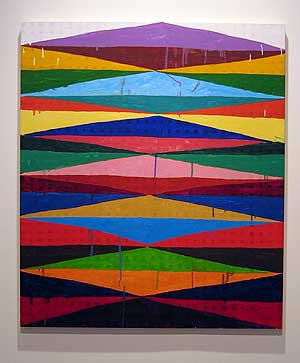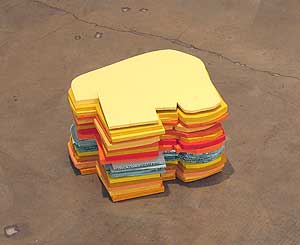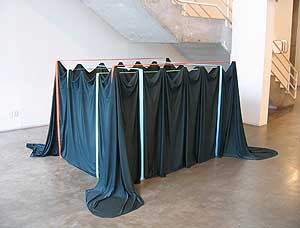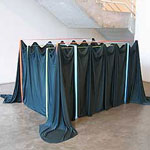Bill Davenport: So let’s get going on this “conversation” that Rachel Cook wants us to have. You do all the work, and we’ll split the money down the middle, OK? So, what did you think of the show?

Carl Suddath... Blue Turning Grey... 2006...paint on wood...37x37x34 1/2 inches... Courtesy Inman Gallery...
Michelle White: That sounds like a wonderful idea! I loved the show for asking such provocative questions about the status of formalism in contemporary art, but doing so without being polemic or trying to come up with an answer. A few weeks ago, I went to a panel discussion at Wade Wilson on concrete art. Joseph Marioni firmly positioned his color field paintings as a continuation of the legacy of Jackson Pollock and Mark Rothko. Is this possible, even in a moment after all of the cynicism of postmodernism? I like how this show posits that kind of problem.
BD: I liked the show as well, but less universally on my third, more analytical visit. The work is so well-coordinated, sparsely hung and decorative that it’s not until you start looking at individual pieces that the holes become apparent.
The work is formal, it’s true, but what isn’t? I’d say rather that the general slant of the show is toward understatement. It’s all a little apologetic, in a cheery, clean, domestic way. The show is very polite.
MW: Given the title of the exhibition, it is perfect that you mention the idea of etiquette. What you describe as a cheerful (and domestic) mindfulness of manners is a productive way to discuss the artists” mutual allegiance to the tradition of formalism — which, I would still argue, is the premise of the show. Sure, there are formal aspects to any work, but I think the curators, Jeff Ward and Shannon Stratton, are relating to the term’s association to the tradition of modern abstraction: there is clearly an earnest investigation going on here that initially seems outmoded.
Perhaps what you see as a problematic, or too cute, negotiation in a “clean” space of cloth and craft and décor (all historically pejorative terms that modernism tried to eliminate) is the point.
BD: I wouldn’t call it an “allegiance” with formalism. Allegiance is something given to a walled totalitarian state. None of the artists in this show is making such an affirmative stand for pure form, the way people used to.
MW: Maybe my use of the word “allegiance” was too strong. However, I will stick to my guns and say that there is an abiding belief in the historical tenets of formalism going on here. It comes not so much from a search for purity as from a lack of irony.
I like this apologetic subtext. Unlike recent shows that have come through, like Populence at the Blaffer Gallery or Landscape Confections at the Contemporary Art Museum Houston, the work presented here does not simply delight in a modern language, or see a gleeful abandon to surface and optical effects as an end in itself. Todd Chilton’s geometric and painterly compositions, for example, are visual treats, and while they convey a playful and grimy material flirtation with the history of painting, there is still a wonderful sense of restraint, more like Frank Stella’s early stripes than eye candy.
BD: “Restrained” is right. I bypassed Todd Chilton’s paintings the first time I saw them. On reflection, they get better and better. They have the dead simple, methodical intensity of a skilled child icing a birthday cake, and they’re just as sweet.
Mung Lar Lam’s ironed cotton pieces are so much the fabric of everyday life, it requires an effort to see them at all. After you wrench your perception out of its groove and look at them as pictures rather than pillowcases, they’re aimless compositions of starched lines vaguely recalling architecture and cubism. The act of wrenching is interesting, but the disappointingly literal overlay of housework/artwork slots the pieces into a too-tidy conceptual pigeonhole.
MW: I agree, Lam and Tomlinson’s work is perhaps not best understood in terms of its subtlety. In fact, Lam’s beautiful play with creases of starched fabric is so wonderfully drenched in gender/identity politics that this issue almost negates the curatorial argument.
The work of Carl Suddath and Katy Heinlein, two Houston-based sculptors, however, fully establishes this notion of how restraint can be successfully used. I was delighted to see their sculpture in conversation because I have always thought of their work as similar: both invite you in with a sense of familiarity and material seduction, but then make the object fall wonderfully from meaning as soon as you try to make a concrete representational link. For instance, Suddath’s wood sculpture Blue Turning Grey initially looks like an upside-down magazine rack. The more you look, the more meaningless or functionless it becomes. Similarly, Heinlein manages to put her tactile and fashion-inspired handling of skirts, drapes of tented terrycloth and taut bands of bright smooth fabric into a situation that demands that you only read it as formal and non-narrative. It is a refreshing take on a particular minimalist and post-minimalist vocabulary that might otherwise seem worn out.
BD: Paul Jackson’s 28 rods in armoury grey can also be seen as a domesticated portrait of minimalist sculpture. Where Carl Andre would have used real steel pipes and resorted to some tricky hidden mechanism to make them stack in a perfect triangle, Jackson is matter-of-fact in the other way: he stacks tricky tubes, which might or might not be steel, on an obvious floor rack. In Jackson’s piece, the emphasis is on how it was made and what it represents, while in Andre’s, it’s on what it is and how it looks.
It’s a little repetitive, but I want to praise Suddath’s Blue Turning Grey, too. Quiet, compact and satisfying, it’s too much like a filing cabinet to be the Boston City Hall, and too much like an air conditioner to be either. It’s one of those useful, ubiquitous objects that would be well nigh invisible if it weren”t in the way.
MW: Right, and while Suddath’s work functions as a nonreferential object, ties to industrial or mass consumption and to acts of labor and commerce are evident in the handmade care that went into its fabrication. You can’t avoid them, but it helps his forms do such an amazing job of inviting but then blocking metaphoric associations. Suddath’s working process is very different from the modernist act of creating an autonomous object that is totally disengaged from the everyday, but it is still worlds apart from what we might expect from a postmodern use of a theoretical vocabulary.
BD: Anyway, I’m more interested in what the pieces are doing than in the historical antecedents of their style. Suddath’s work is soothing. Myers” is folksy; Jackson’s, exuberantly technophile; Lam’s, icy cool; Flanigan’s, abject; Tomlinson’s, nervous; Chilton’s, resigned. The boys paint and build; the girls sew, fold and drape. Hmmm . . .
MW: The boys versus girls is really interesting. Lam’s work is an awkward fit in the show because it is so engaged with a feminist history, specifically women’s work. Her patterns of starchy creased fabric, pressed in origami-like folds with an iron, bring to mind Sol LeWitt’s work with folded paper grids, but also Susan Orgal’s 1971 performance when she ironed sheets in real time at Project Womanhouse to investigate the drudgery of household chores. The tiny labels that Lam sticks to the corners with the date that mark when she made the folds, along with past exhibitions when she actually displayed the ironing board and even performed the act in front of the viewer, draw on this interest in the gendered division of labor. But, I don’t know, maybe this issue is no longer applicable. Do you think that like Heinlein’s work with fabric, Lam’s stunning results almost get around the poetically political element and feminist critique that is inherent when soft materials associated with domesticity reference the hard masculine forms of minimalism?
BD: I think it’s just that many of the pieces evoke the personalities of their makers, which are inevitably gendered. Women’s statements of identity tend to be politicized, given recent history. Andrea Myers is an exception. Rise , her colorful stack of chunky toy bear/elephant shapes, is more about childlike cutting and pasting than gender. Kirsten Flanigan’s dollhouse-scale bedding, Heinlein’s satin-draped rump, Jackson’s industrial piping — all are fairly gender-specific.
What’s that? Time’s up? This piece is already getting too long? But there’s so much more to talk about . . .
MW: …and we were just getting to the good part: the enduring conflict on how to read a work of art! Of course, meaning gets squeezed from personality and stuff like identity, but coming from a curatorial position, I think that what is ultimately most interesting about this show is how it points out a trend in art making, a sincere retake on a historical language that provides the opportunity to think about why playing with the grammatical rules, or the “ps and qs,” of formalism is important now.
Thanks for the conversation.
Images courtesy Bill Davenport.
Bill Davenport is an artist and writer currently living in Houston. Michelle White is a curatorial assiant for the Menil Collection.






